Apple iPad - iOS 6.1, iPad 2 - iOS 6.1, iPad Mini - iOS 6.1 Operating Instructions

iPad User Guide
For iOS 6.1 Software
Contents
7 Chapter 1: iPad at a Glance
7iPad Overview
8Accessories
9Buttons
11SIM card tray
12Status icons
13Chapter 2: Getting Started
13What you need
13Setting up iPad
14Apple ID
14Setting up mail and other accounts
14Managing content on iPad
15Using iCloud
16Connecting iPad to your computer
16Syncing with iTunes
17Viewing this user guide on iPad
18Chapter 3: Basics
18 Using apps
21Customizing iPad
22Typing
26Dictation
27Searching
28Notifications
29Sharing
30Connecting iPad to a TV or other device
30Printing with AirPrint
32Bluetooth devices
32File sharing
33Security features
34Battery
35 Chapter 4: Siri
35What is Siri?
36Using Siri
38Restaurants
39Movies
39Sports
39Dictation
40Correcting Siri
2
41 Chapter 5: Safari
44 Chapter 6: Mail
44Reading mail
45Sending mail
46Organizing mail
46Printing messages and attachments
47Mail accounts and settings
48Chapter 7: Messages
48Sending and receiving messages
49Managing conversations
49Sending photos, videos, and more
50Messages settings
51Chapter 8: FaceTime
53 Chapter 9: Camera
53At a glance
54Viewing, sharing, and printing
55Editing photos and trimming videos
56Chapter 10: Photos
56Viewing photos and videos
57Organizing photos and videos
57Photo Stream
59Sharing photos and videos
59Printing photos
59Picture Frame
60Importing photos and videos
61 Chapter 11: Photo Booth
61Taking photos
62Managing photos
63Chapter 12: Videos
65 Chapter 13: Calendar
65At a glance
66Working with multiple calendars
67Sharing iCloud calendars
67Calendar settings
68Chapter 14: Contacts
68At a glance
69Adding contacts
70Contacts settings
Contents |
3 |
71Chapter 15: Notes
72Chapter 16: Reminders
74Chapter 17: Clock
75Chapter 18: Maps
75Finding locations
76Getting directions
773D and Flyover
77Maps settings
78Chapter 19: Music
78Getting music
78Playing music
79Podcasts and audiobooks
80Playlists
80Genius
81Siri
81iTunes Match
82Home Sharing
82Music settings
83Chapter 20: iTunes Store
85 Chapter 21: App Store
85At a glance
86Deleting apps
87Chapter 22: Newsstand
88Chapter 23: iBooks
88At a glance
89Reading books
90Interacting with multimedia
90Studying notes and vocabulary lists
91Organizing the bookshelf
92Syncing books and PDFs
92Printing or emailing a PDF
92iBooks settings
93Chapter 24: Podcasts
95 Chapter 25: Game Center
95At a glance
96Playing with friends
96Game Center settings
97Chapter 26: Accessibility
97Accessibility features
97VoiceOver
106Siri
Contents |
4 |
106Triple-click Home
106Zoom
106Large Text
107Invert Colors
107Speak Selection
107Speak Auto-Text
107Mono Audio
107Assignable tones
107Guided Access
108AssistiveTouch
109Widescreen keyboards
109Closed captioning
109Accessibility in OS X
110Chapter 27: Settings
110Airplane mode
110Wi-Fi
111VPN
111Personal Hotspot
112Bluetooth
112Cellular Data
113Do Not Disturb & Notifications
114General
118 Sounds
118Brightness & Wallpaper
119Picture Frame
119Privacy
120Appendix A: iPad in Business
120iPad in the enterprise
120Using configuration profiles
120Setting up Microsoft Exchange accounts
121VPN access
121LDAP and CardDAV accounts
122Appendix B: International Keyboards
122Using international keyboards
123Special input methods
125 Appendix C: Safety, Handling, & Support
125 Important safety information
127Important handling information
127iPad Support
128Low-battery image or “Not Charging” message appears
128iPad doesn’t respond
128Restarting and resetting iPad
129“Wrong Passcode” or “iPad is disabled” appears
129 “This accessory is not supported by iPad” appears
129 An app doesn’t fill the screen
129 Onscreen keyboard doesn’t appear
129 Backing up iPad
Contents |
5 |
131Updating and restoring iPad software
131Sending, receiving, or viewing email
132Sound, music, and video
134 iTunes Store and App Store
134Learning more, service, and support
135Disposal and recycling information
136Apple and the environment
Contents |
6 |

iPad at a Glance |
1 |
|
Read this chapter to learn about iPad features, how to use the controls, and more.
iPad Overview
iPad mini
Status bar |
FaceTime |
camera |
App icons
Multi-Touch display
Home
|
|
|
|
|
|
|
Sleep/ |
|
|
|
|
iSight |
|
Wake |
|
Microphone |
|||||||
|
|
||||||||||
|
|
|
|
|
|
||||||
|
|
|
|
|
|||||||
camera |
|
|
|
|
|
|
|
|
|
Headset jack |
|
|
|
|
|
||||||||
Side Switch |
|
|
|
|
|
|
|
|
|||
|
|
|
|
|
|
|
|
|
|||
Volume |
|
|
|
|
|
|
|
|
|
|
|
|
|
|
|
|
|
|
|||||
up/down |
|
|
|
|
|||||||
Nano SIM |
|
|
|
|
|
|
Speakers |
|
|
|
|
|
|
||
|
|
|
|
|
|
|
|
|
|
|
|
|
|
|
|
tray (on some |
|
|
|
|
|||
|
|
|
|
||||
models) |
|
Lightning connector |
|||||
|
|||||||
7
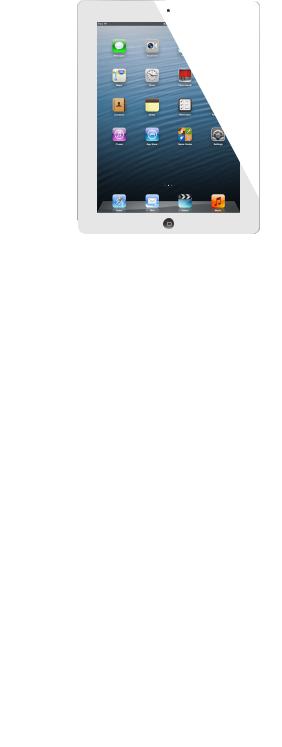
iPad
Status bar |
FaceTime |
camera |
App icons
|
|
|
|
|
|
|
|
|
|
|
|
|
|
|
|
|
Multi-Touch |
|
|
|
|
|
|
|
|
|
|
|
|
|
|
|
|
|
|
||
|
|
|
|
|
|
|
|
|
|
|
|
|
|
|
|
|
display |
|
Home |
|
|
|
|
|
|
|
|
|
|
|
|
|
|
|
|
||
|
|
|
|
|
|
|
|
Sleep/Wake |
Microphone |
Headset jack |
||||||||
iSight |
|
|
|
|
||||||||||||||
|
|
|
|
|
||||||||||||||
|
|
|
|
|
|
|||||||||||||
|
|
|
|
|
|
|
||||||||||||
camera |
|
|
|
|
|
|
|
Micro SIM |
||||||||||
|
||||||||||||||||||
Side Switch |
|
|
|
|
|
|
|
|
|
|
||||||||
|
|
|
|
|
|
|
|
|
|
|
||||||||
|
||||||||||||||||||
Volume |
|
|
|
|
|
|
|
|
|
|
|
|
|
|
tray (on some |
|||
|
|
|
|
|
|
|
|
|
|
|
|
models) |
||||||
up/down |
||||||||||||||||||
|
||||||||||||||||||
|
|
|
|
|
|
Speaker |
|
Lightning connector |
|
|
|
|||
Your iPad features and the Home screen may be different, depending on the model of iPad you have.
Accessories
The following accessories are included with iPad:
USB power adapter: Use the included power adapter to power iPad and charge the battery.
Note: The power adapter included with iPad may vary by model and region.
Chapter 1 iPad at a Glance |
8 |
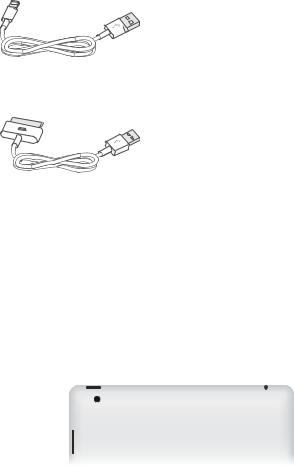
Lightning to USB Cable: Use this to connect iPad 4th generation or iPad mini to the USB power adapter to charge, or to your computer to sync.
30-pin to USB Cable: Use this to connect iPad 2 or iPad 3rd generation to the USB power adapter to charge, or to your computer to sync. Use the cable with the optional iPad Dock, or plug it directly into iPad.
Buttons
A few buttons make it easy to lock iPad and adjust the volume.
Sleep/Wake button
You can lock iPad by putting it to sleep when you’re not using it. When you lock iPad, nothing happens if you touch the screen, but music continues playing and you can use the volume button.
Sleep/Wake button
button 
Lock iPad: Press the Sleep/Wake button.
Unlock iPad: Press the Home button  or the Sleep/Wake button, then drag the slider.
or the Sleep/Wake button, then drag the slider.
Turn iPad off: Hold down the Sleep/Wake button for a few seconds until the red slider appears, then drag the onscreen slider.
Turn iPad on: Hold down the Sleep/Wake button until the Apple logo appears.
If you don’t touch the screen for a minute or two, iPad locks automatically. You can change how long it takes the screen to lock, or set a passcode to unlock iPad.
Set the auto-lock time: Go to Settings > General > Auto-Lock. Set a passcode: Go to Settings > General > Passcode Lock.
You can use an iPad Smart Cover or iPad Smart Case, sold separately, to automatically lock or unlock an iPad 2 or later.
Use an iPad Smart Cover or iPad Smart Case: Go to Settings > General > iPad Cover Lock/Unlock.
Chapter 1 iPad at a Glance |
9 |

Home button
The Home button  lets you get back to the Home screen at any time. It also provides other convenient shortcuts.
lets you get back to the Home screen at any time. It also provides other convenient shortcuts.
Go to the Home screen: Press the Home button  .
.
On the Home screen, tap an app to open it. See Opening and switching between apps on page 18.
Display recently used apps: When iPad is unlocked, double-click the Home button  . The multitasking bar appears at the bottom of the screen, showing the most recently used apps. Swipe the bar to the left to see more apps.
. The multitasking bar appears at the bottom of the screen, showing the most recently used apps. Swipe the bar to the left to see more apps.
Display audio playback controls:
•• When iPad is locked: Double-click the Home button  . See Playing music on page 78.
. See Playing music on page 78.
•• When using another app: Double-click the Home button  , then flick the multitasking bar from left to right.
, then flick the multitasking bar from left to right.
Use Siri (iPad 3rd generation or later): Press and hold the Home button  . See Chapter 4, Siri, on page 35.
. See Chapter 4, Siri, on page 35.
Volume button and Side Switch
Use the Side Switch to disable audio alerts and notifications.You can also use it to lock the screen rotation and prevent the iPad display from switching between portrait and landscape mode.
Adjust the volume: Press the Volume button up or down to increase or decrease the volume.
•• Mute the sound: Press and hold the bottom end of the Volume button.
•• Set a volume limit: Go to Settings > Music > Volume Limit.
Mute notifications, alerts, and sound effects: Slide the Side Switch down.
The Side Switch doesn’t mute audio playback, such as music, podcasts, movies, and TV shows. See Side Switch on page 117.
Lock the screen rotation: Go to Settings > General > “Use the Side Switch to…,” then tap Lock Rotation.
Use the Volume button to adjust the volume of songs and other media, and of alerts and sound effects.
Side
Switch

Volume up/down
up/down
WARNING: For important information about avoiding hearing loss, see Important safety information on page 125.
You can also use the Do Not Disturb setting to silence FaceTime calls, alerts, and notifications.
Set iPad to Do Not Disturb: Go to Settings and turn on Do No Disturb. Do Not Disturb keeps alerts and notifications from making any sounds or lighting up the screen when the screen is locked. Alarms, however, still sound, and if the screen is unlocked, Do Not Disturb has no effect.
To schedule quiet hours, allow specific people to call, or allow repeated FaceTime calls to ring through, go to Settings > Notifications > Do Not Disturb. See Do Not Disturb & Notifications on page 113.
Chapter 1 iPad at a Glance |
10 |
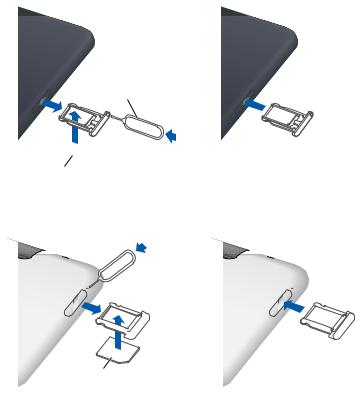
SIM card tray
The SIM card in iPad Wi-Fi + cellular models is used for cellular data. If your SIM card wasn’t preinstalled or if you change cellular data carriers, you may need to install or replace the SIM card.
iPad mini Wi-Fi + cellular
SIM eject tool

 SIM Nano SIM tray card
SIM Nano SIM tray card
iPad Wi-Fi + cellular
 SIM eject tool
SIM eject tool


 SIM tray
SIM tray
Micro SIM card
Open the SIM tray: Insert the tip of the SIM eject tool into the hole on the SIM tray. Press firmly and push the tool straight in until the tray pops out. Pull out the SIM tray to install or replace the SIM card. If you don’t have a SIM eject tool, you may be able to use the end of a small paper clip.
For more information, see Cellular Data on page 112.
Chapter 1 iPad at a Glance |
11 |
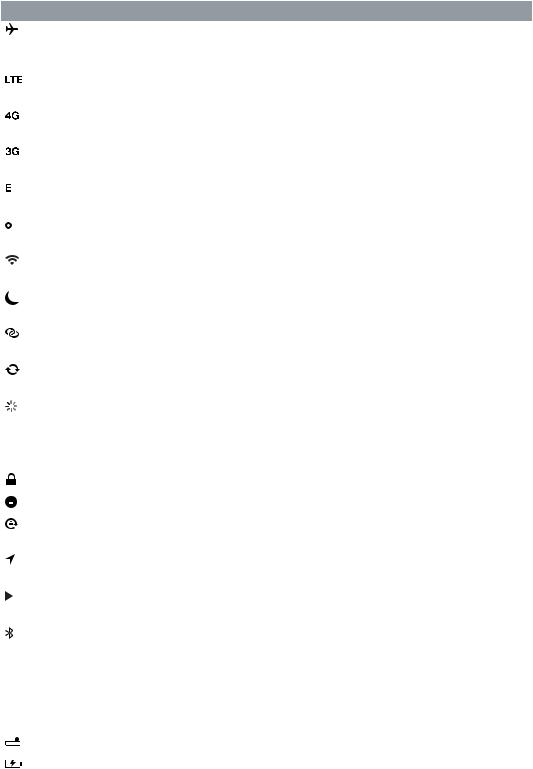
Status icons
The icons in the status bar at the top of the screen give information about iPad:
|
Status icon |
What it means |
||||
|
|
|
|
|
Airplane mode |
Shows that airplane mode is on—you can’t access the Internet, or |
|
|
|
|
|
|
use Bluetooth® devices. Non-wireless features are available. See |
|
|
|
|
|
|
Airplane mode on page 110. |
|
|
|
|
|
|
|
|
|
|
|
|
LTE |
Shows that iPad (Wi-Fi + cellular models) is connected to the |
|
|
|
|
|
|
Internet over a 4G LTE network. |
|
|
|
|
|
|
|
|
|
|
|
|
4G |
Shows that iPad (Wi-Fi + cellular models) is connected to the |
|
|
|
|
|
|
Internet over a 4G network. |
|
|
|
|
|
|
|
|
|
|
|
|
3G |
Shows that iPad (Wi-Fi + cellular models) is connected to the |
|
|
|
|
|
|
Internet over a 3G network. |
|
|
|
|
|
|
|
|
|
|
|
|
EDGE |
Shows that iPad (Wi-Fi + cellular models) is connected to the |
|
|
|
|
|
|
Internet over an EDGE network. |
|
|
|
|
|
|
|
|
|
|
|
|
GPRS |
Shows that iPad (Wi-Fi + cellular models) is connected to the |
|
|
|
|
|
|
Internet over a GPRS network. |
|
|
|
|
|
|
|
|
|
|
|
|
Wi-Fi |
Shows that iPad has a Wi-Fi Internet connection. The more bars, the |
|
|
|
|
|
|
stronger the connection. See Joining a Wi-Fi network on page 110. |
|
|
|
|
|
|
|
|
|
|
|
|
Do Not Disturb |
Shows that “Do Not Disturb” is turned on. See Do Not Disturb & |
|
|
|
|
|
|
Notifications on page 113. |
|
|
|
|
|
|
|
|
|
|
|
|
Personal Hotspot |
Shows that iPad is providing a Personal Hotspot to another iPad, |
|
|
|
|
|
|
iPhone, or iPod touch. See Personal Hotspot on page 111. |
|
|
|
|
|
|
|
|
|
|
|
|
Syncing |
Shows that iPad is syncing with iTunes. See Syncing with iTunes on |
|
|
|
|
|
|
page 16. |
|
|
|
|
|
|
|
|
|
|
|
|
Activity |
Shows network and other activity. Some third-party apps use this |
|
|
|
|
|
|
icon to show an active process. |
|
|
|
|
|
|
|
|
|
|
|
|
VPN |
Shows that you’re connected to a network using VPN. See VPN on |
|
|
|
|
|
||
|
|
|
|
|
||
|
|
|
|
|
|
page 111. |
|
|
|
|
|
|
|
|
|
|
|
|
Lock |
Shows that iPad is locked. See Sleep/Wake button on page 9. |
|
|
|
|
|
|
|
|
|
|
|
|
Alarm |
Shows that an alarm is set. See Chapter 17, Clock, on page 74. |
|
|
|
|
|
||
|
|
|
|
|
||
|
|
|
|
|
|
|
|
|
|
|
|
Screen orientation |
Shows that the screen orientation is locked. See Portrait and |
|
|
|
|
|
lock |
landscape orientation on page 20. |
|
|
|
|
|
|
|
|
|
|
|
|
Location Services |
Shows that an app is using Location Services. See Privacy on |
|
|
|
|
|
|
page 119. |
|
|
|
|
|
|
|
|
|
|
|
|
Play |
Shows that a song, audiobook, or podcast is playing. See Playing |
|
|
|
|
|
|
music on page 78. |
|
|
|
|
|
|
|
|
|
|
|
|
Bluetooth |
White icon: Bluetooth is on and paired with a device, such as a |
|
|
|
|
|
|
headset or keyboard. |
|
|
|
|
|
|
Gray icon: Bluetooth is on and paired with a device, but the device is |
|
|
|
|
|
|
out of range or turned off. |
|
|
|
|
|
|
No icon: Bluetooth is not paired with a device. |
|
|
|
|
|
|
See Bluetooth devices on page 32. |
|
|
|
|
|
|
|
|
|
|
|
|
Bluetooth battery |
Shows the battery level of a supported paired Bluetooth device. |
|
|
|
|
|
||
|
|
|
|
|
|
|
|
|
|
|
|
Battery |
Shows the battery level or charging status. See Battery on page 34. |
|
|
|
|
|
|
|
Chapter 1 iPad at a Glance |
12 |

Getting Started |
2 |
|
Read this chapter to learn how to set up iPad, set up mail accounts, use iCloud, and more.
What you need
·WARNING: To avoid injury, read Important safety information on page 125 before using iPad.
To use iPad, you need:
•• An Internet connection (broadband is recommended)
•• An Apple ID for some features, including iCloud, the App Store and iTunes Store, and online purchases. You can create an Apple ID during setup.
To use iPad with your computer, you need:
•• A Mac with a USB 2.0 or 3.0 port, or a PC with a USB 2.0 port, and one of the following operating systems:
•• Mac OS X version 10.6.8 or later
•• Windows 7, Windows Vista, or Windows XP Home or Professional with Service Pack 2 or later
•• iTunes, available at www.itunes.com/download
Setting up iPad
To set up iPad, turn it on and follow the Setup Assistant. The onscreen directions in Setup Assistant step you through the setup process, including:
••
••
••
••
Connecting to a Wi-Fi network
Signing in with or creating a free Apple ID Setting up iCloud
Turning on recommended features, such as Location Services and Find My iPad
During setup, you can copy your apps, settings, and content from another iPad by restoring from an iCloud backup or from iTunes. See Backing up iPad on page 129.
13
Apple ID
An Apple ID is the user name for a free account that lets you access Apple services, such as the iTunes Store, the App Store, and iCloud. You need only one Apple ID for everything you do with Apple. There may be charges for services and products that you use, purchase, or rent.
If you have an Apple ID, use it when you first set up iPad, and whenever you need to sign in to an
Apple service. If you don’t already have an Apple ID, you can create one now, or later when you’re asked to sign in.
Create an Apple ID: Go to Settings > iTunes & App Stores and tap Sign In. (If you’re already signed in and want to create another Apple ID, first tap your Apple ID, then tap Sign Out.)
For more information, see support.apple.com/kb/he37.
Setting up mail and other accounts
iPad works with iCloud, Microsoft Exchange, and many of the most popular Internet-based mail, contacts, and calendar service providers.
If you don’t already have a mail account, you can set up a free iCloud account when you set up iPad, or set one up later in Settings > iCloud. See Using iCloud on page 15.
Set up an iCloud account: Go to Settings > iCloud.
Set up another account: Go to Settings > Mail, Contacts, Calendars.
You can add contacts using an LDAP or CardDAV account, if your company or organization supports it. See Adding contacts on page 69.
For information about setting up a Microsoft Exchange account in a corporate environment, see Setting up Microsoft Exchange accounts on page 120.
Managing content on iPad
You can transfer information and files between iPad and your other iOS devices and computers, using either iCloud or iTunes.
••
••
iCloud stores content such as music, photos, calendars, contacts, documents, and more, and wirelessly pushes it to your other iOS devices and computers, keeping everything up to date. See Using iCloud, below.
iTunes syncs music, video, photos, and more between your computer and iPad. Changes you make on one device are copied to the other when you sync. You can also use iTunes to
copy a file to iPad for use with an app, or to copy a document you’ve created on iPad to your computer. See Syncing with iTunes on page 16.
You can use iCloud or iTunes, or both, depending on your needs. For example, you can use iCloud Photo Stream to automatically push photos you take on iPad to your other devices, and use iTunes to sync photo albums from your computer to iPad.
Note: Don’t sync items in the Info pane of iTunes (such as contacts, calendars, and notes) and also use iCloud to keep that information up to date on your devices. Otherwise, you may see duplicated data on iPad.
Chapter 2 Getting Started |
14 |
Using iCloud
iCloud stores your content, including music, photos, contacts, calendars, and supported documents. Content stored in iCloud is pushed wirelessly to your other iOS devices and computers set up with the same iCloud account.
iCloud is available on iOS devices with iOS 5 or later, on Mac computers with OS X Lion v10.7.2 or later, and on PCs with the iCloud Control Panel for Windows (Windows Vista Service Pack 2 or Windows 7 required).
iCloud features include:
••
••
••
••
••
••
••
••
••
••
iTunes in the Cloud—Download previous iTunes music and TV show purchases to iPad for free, anytime.
Apps and Books—Download previous App Store and iBookstore purchases for free, anytime.
Photo Stream—Photos you take on one device appear automatically on all your devices. See Photo Stream on page 57.
Documents in the Cloud—For iCloud-enabled apps, keep documents and app data up to date across all your devices.
Mail, Contacts, Calendars—Keep your mail contacts, calendars, notes, and reminders up to date across all your devices.
Backup—Back up iPad to iCloud automatically when connected to power and Wi-Fi. See Backing up with iCloud on page 129.
Find My iPad—Locate your iPad on a map, display a message, play a sound, lock the screen, or remotely wipe the data. See Find My iPad on page 33.
Find My Friends—Keep track of your family and friends (when connected to a Wi-Fi or cellular network) using the Find My Friends app. Download the free app from the App Store.
iTunes Match—With an iTunes Match subscription, all your music, including music you’ve imported from CDs or purchased somewhere other than iTunes, appears on all your devices and can be downloaded and played on demand. See iTunes Match on page 81.
iCloud Tabs—See the webpages you have open on your other iOS devices or computers with OS X Mountain Lion or later installed. See Chapter 5, Safari, on page 41.
With iCloud, you get a free mail account and 5 GB of storage for your mail, documents, and backups. Your purchased music, apps, TV shows, and books, as well as your Photo Stream, don’t count against your free space.
Note: iCloud is not available in all areas, and iCloud features may vary by area. For more information, go to www.apple.com/icloud.
Sign in or create an iCloud account: Go to Settings > iCloud.
Manage iCloud: Go to Settings > iCloud.
•• Enable or disable services: Go to Settings > iCloud, then turn on services such as Photo Stream and Documents & Data.
•• Enable iCloud backups: Go to Settings > iCloud > Storage & Backup.
•• Buy more iCloud storage: Go to Settings > iCloud > Storage & Backup > Manage Storage > Change Storage Plan, then choose an upgrade.
For information about buying iCloud storage, go to help.apple.com/icloud.
Turn on Automatic Downloads for music, apps, or books: Go to Settings > Store.
Chapter 2 Getting Started |
15 |
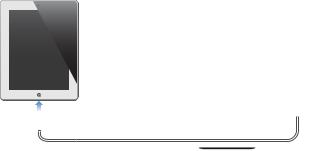
View and download previous purchases:
•• iTunes Store purchases: Go to iTunes, then tap Purchased  .
.
•• App Store purchases: Go to App Store, then tap Purchased  .
.
•• iBookstore purchases: Go to iBooks, tap Store, then tap Purchased  .
.
Find your iPad: Go to www.icloud.com, sign in with your Apple ID, then choose Find My iPad.
Important: On your iPad, Find My iPad must be turned on in Settings > iCloud in order for iPad to be located.
For more information about iCloud, go to www.apple.com/icloud. For support information, go to www.apple.com/support/icloud.
Connecting iPad to your computer
Use the included USB cable to connect iPad to your computer. Connecting iPad to your computer lets you sync information, music, and other content with iTunes. You can also sync with iTunes wirelessly. See Syncing with iTunes on page 16.
Unless iPad is syncing with your computer, you can disconnect it at any time. If you disconnect while a sync is in progress, some data may not get synced until the next time you connect iPad to your computer.
Syncing with iTunes
Syncing with iTunes copies information from your computer to iPad, and vice versa. You can sync by connecting iPad to your computer with the included USB cable, or you can set up iTunes to sync wirelessly using Wi-Fi. You can set iTunes to sync music, photos, videos, podcasts, apps, and more. For information about syncing iPad, open iTunes on your computer, then select iTunes Help from the Help menu.
Set up wireless iTunes syncing: Connect iPad to your computer using the included USB cable. In iTunes on your computer, select iPad, click Summary, then turn on “Sync with this iPad over Wi-Fi.”
When Wi-Fi syncing is turned on, iPad automatically syncs every day. iPad must be connected to a power source, both iPad and your computer must be on the same wireless network, and iTunes must be open on the computer. For more information, see iTunes Wi-Fi Sync on page 115.
Chapter 2 Getting Started |
16 |
Tips for syncing with iTunes
••
••
••
••
••
••
••
••
If you use iCloud to store your contacts, calendars, bookmarks, and notes, don’t also sync them to iPad using iTunes.
Purchases you make from the iTunes Store or the App Store on iPad are synced back to your iTunes library. You can also purchase or download content and apps from the iTunes Store on your computer, and then sync them to iPad.
In the device’s Summary pane, you can set iTunes to automatically sync iPad when it’s attached to your computer. To temporarily override this, hold down Command and Option (Mac) or Shift and Control (PC) until you see your iPad appear in the iTunes window.
In the device’s Summary pane, select “Encrypt iPad backup” if you want to encrypt the information stored on your computer when iTunes makes a backup. Encrypted backups are indicated by a lock icon  , and a password is required to restore the backup. If you don’t select this option, other passwords (such as those for mail accounts) aren’t included in the backup and will have to be reentered if you use the backup to restore iPad.
, and a password is required to restore the backup. If you don’t select this option, other passwords (such as those for mail accounts) aren’t included in the backup and will have to be reentered if you use the backup to restore iPad.
In the device’s Info pane, when you sync mail accounts, only the settings are transferred from your computer to iPad. Changes you make to a mail account on iPad don’t affect the account on your computer.
In the device’s Info pane, click Advanced to select options that let you replace the information on iPad with the information from your computer during the next sync.
If you listen to part of a podcast or audiobook, your stopping point is included if you sync the content with iTunes. If you started listening on iPad, you can pick up where you left off in iTunes on your computer—or vice versa.
In the device’s Photo pane, you can sync photos and videos from a folder on your computer.
Viewing this user guide on iPad
You can view the iPad User Guide on iPad in Safari, and in the free iBooks app.
View the user guide in Safari: In Safari, tap  , then tap the iPad User Guide bookmark. Or go to help.apple.com/ipad.
, then tap the iPad User Guide bookmark. Or go to help.apple.com/ipad.
Add an icon for the user guide to the Home screen: Tap  , then tap “Add to Home Screen.”
, then tap “Add to Home Screen.”
View the user guide in iBooks: If you haven’t installed iBooks, open the App Store, then search for and install “iBooks.” Open iBooks and tap Store. Search for “iPad User Guide,” then select and download the user guide.
For more information about iBooks, see Chapter 23, iBooks, on page 88.
Chapter 2 Getting Started |
17 |
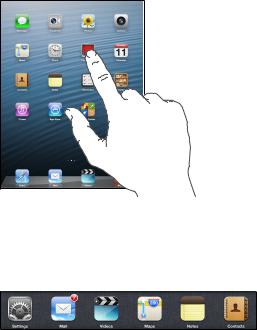
Basics |
3 |
|
Using apps
You interact with iPad using your fingers to tap, double-tap, swipe, and pinch objects on the touchscreen.
Opening and switching between apps
To go to the Home screen, press the Home button  .
.
Open an app: Tap it.
To return to the Home screen, press the Home button  again.
again.
View recently used apps: Double-click the Home button  to reveal the multitasking bar. Tap an app to use it again. Swipe left to see more apps.
to reveal the multitasking bar. Tap an app to use it again. Swipe left to see more apps.
If you have a lot of apps, you might want to use Spotlight to locate and open them. See Searching on page 27.
18
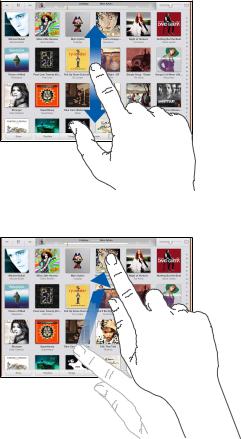
Scrolling
Drag up or down to scroll. On some screens such as webpages, you can also scroll side to side.
Dragging your finger to scroll doesn’t choose or activate anything on the screen.
Flick to scroll quickly.
You can wait for the scrolling to come to a stop, or touch anywhere on the screen to stop it immediately.
To quickly go to the top of a page, tap the status bar at the top of the screen.
Lists
Depending on the list, choosing an item can do different things—for example, it may open another list, play a song, open an email, or show someone’s contact information.
Choose an item in a list: Tap it.
Some lists have an index along the side to help you navigate quickly.
Find items in an indexed list: Tap a letter to jump to items starting with that letter. Or, drag your finger along the index to scroll quickly through the list.
Return to a previous list or screen: Tap the back button in the upper-left corner.
Chapter 3 Basics |
19 |
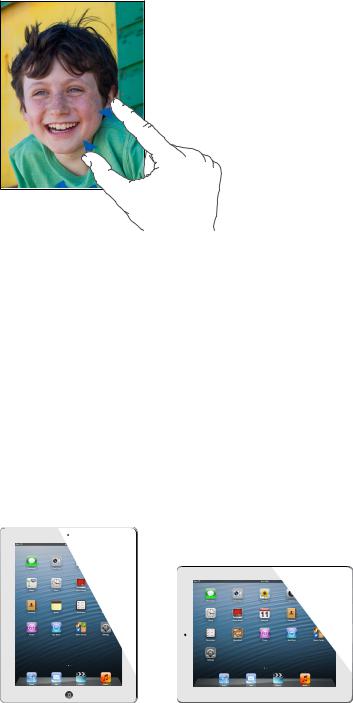
Zooming in or out
Depending on the app, you may be able to zoom in to enlarge, or zoom out to reduce the image on the screen. When viewing photos, webpages, mail, or maps, for example, pinch two fingers together to zoom out or spread them apart to zoom in. For photos and webpages, you can also double-tap (tap twice quickly) to zoom in, then double-tap again to zoom out. For maps, double-tap to zoom in and tap once with two fingers to zoom out.
Zoom is also an accessibility feature that lets you magnify the entire screen of any app you’re using and helps you see what’s on the display. See Zoom on page 106.
Multitasking gestures
You can use multitasking gestures on iPad to return to the Home screen, reveal the multitasking bar, or switch to another app.
Return to the Home screen: Pinch four or five fingers together. Reveal the multitasking bar: Swipe up with four or five fingers. Switch apps: Swipe left or right with four or five fingers.
Turn multitasking gestures on or off: Go to Settings > General > Multitasking Gestures.
Portrait and landscape orientation
You can view many iPad apps in either portrait or landscape orientation. Rotate iPad and the screen rotates too, adjusting to fit the new orientation.
Lock the screen orientation: Double-click the Home button  , swipe the multitasking bar from left to right, then tap
, swipe the multitasking bar from left to right, then tap  .
.
Chapter 3 Basics |
20 |
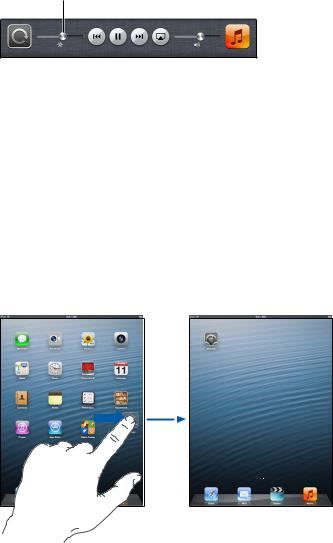
The orientation lock icon  appears in the status bar when the screen orientation is locked.
appears in the status bar when the screen orientation is locked.
You can also set the Side Switch to lock the screen orientation instead of silencing sound effects and notifications. Go to Settings > General, and under“Use Side Switch to,”tap Lock Rotation. See
Side Switch on page 117.
Adjusting the screen brightness
You can manually adjust the brightness of the screen, or turn on Auto-Brightness to have iPad use the built-in ambient light sensor to automatically adjust the brightness.
Adjust the screen brightness: Double-click the Home button  , swipe the multitasking bar from left to right, then drag the brightness slider.
, swipe the multitasking bar from left to right, then drag the brightness slider.
Brightness
Turn Auto-Brightness on or off: Go to Settings > Brightness & Wallpaper.
See Brightness & Wallpaper on page 118.
Customizing iPad
You can customize the layout of your apps on the Home screen, organize them in folders, and change the wallpaper.
Rearranging apps
Customize your Home screen by rearranging apps, moving apps to the Dock along the bottom of the screen, and creating additional Home screens.
Rearrange apps: Touch and hold any app on the Home screen until it jiggles, then move apps around by dragging them. Press the Home button  to save your arrangement.
to save your arrangement.
Create a new Home screen: While arranging apps, drag an app to the right edge of the rightmost screen until a new screen appears.
You can create up to 11 Home screens. The dots above the Dock show the number of screens you have, and which screen you’re viewing.
••
••
Switch between Home screens: Swipe left or right.
Go to the first Home screen: Press the Home button  .
.
Chapter 3 Basics |
21 |
Move an app to another screen: While it’s jiggling, drag an app to the side of the screen.
Customize the Home screen using iTunes: Connect iPad to your computer. In iTunes on your computer, select iPad, then click the Apps button to see the image of the iPad Home screen.
Reset the Home screen to its original layout: Go to Settings > General > Reset, then tap Reset Home Screen Layout. Resetting the Home screen removes any folders you’ve created and applies the default wallpaper to your Home screen.
Organizing with folders
You can use folders to organize the apps on your Home screens. Rearrange folders—just as you do apps—by dragging them around your Home screens or to the Dock.
Create a folder: Touch and hold an app until the Home screen icons begin to jiggle, then drag an app onto another.
iPad creates a new folder that includes the two apps, and names the folder based on the type of apps.To enter a different name, tap the name field.
Open a folder: Tap the folder. To close a folder, tap outside the folder or press the Home button  . Organize with folders: While arranging apps (the icons are jiggling):
. Organize with folders: While arranging apps (the icons are jiggling):
•• Add an app to a folder: Drag the app onto the folder.
•• Remove an app from a folder: Open the folder if necessary, then drag the app out.
•• Delete a folder: Move all apps out of the folder. The folder is automatically deleted.
•• Rename a folder: Tap to open the folder, then tap the name and enter a new one.
When you finish, press the Home button  .
.
Changing the wallpaper
You can customize both the Lock screen and the Home screen by choosing an image or photo to use as wallpaper. Choose one of the supplied images, or a photo from your Camera Roll or another album on iPad.
Change the wallpaper: Go to Settings > Brightness & Wallpaper.
Typing
The onscreen keyboard lets you type when you need to enter text.
Entering text
Use the onscreen keyboard to enter text, such as contact information, mail, and web addresses. Depending on the app and the language you’re using, the keyboard may correct misspellings, predict what you’re typing, and even learn as you use it.
You can also use an Apple Wireless Keyboard to type. See Apple Wireless Keyboard on page 25. To use dictation instead of typing, see Dictation on page 26.
Enter text: Tap a text field to bring up the keyboard, then tap keys on the keyboard.
Chapter 3 Basics |
22 |

As you type, each letter appears above your thumb or finger. If you touch the wrong key, you can slide your finger to the correct key.The letter isn’t entered until you release your finger from the key.
•• |
Type uppercase: Tap the Shift key before tapping a letter. Or touch and hold the Shift key, |
|
|
then slide to a letter. |
|
•• |
Quickly type a period and space: Double-tap the space bar. |
|
•• |
Turn on caps lock: Double-tap the Shift key .To turn caps lock off, tap the Shift key. |
|
•• |
Enter numbers, punctuation, or symbols: Tap the Number key |
. To see additional punctuation |
|
and symbols, tap the Symbol key . |
|
•• |
Enter accented letters or other alternate characters: Touch and hold a key, then slide to choose |
|
|
one of the options. |
|
Hide the onscreen keyboard: Tap the Keyboard key  .
.
Set options for typing: Go to Settings > General > Keyboard.
Editing text
If you need to edit text, an onscreen magnifying glass lets you position the insertion point where you need it. You can select text, and cut, copy, and paste text. In some apps, you can also cut, copy, and paste photos and videos.
Position the insertion point: Touch and hold to bring up the magnifying glass, then drag to position the insertion point.
Select text: Tap the insertion point to display the selection buttons. Tap Select to select the adjacent word, or tap Select All to select all text.
Chapter 3 Basics |
23 |
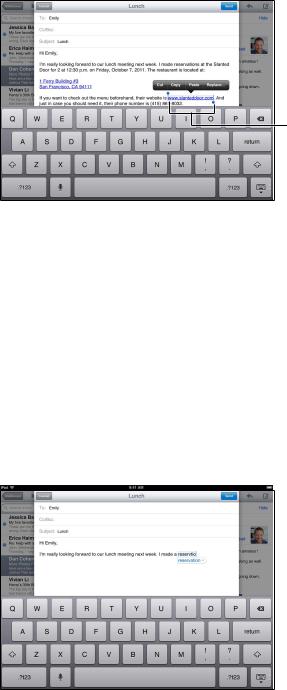
You can also double-tap a word to select it. Drag the grab points to select more or less text. In read-only documents, such as webpages, touch and hold to select a word.
Grab points
Cut or copy text: Select text, then tap Cut or Copy.
Paste text: Tap the insertion point, then tap Paste to insert the last text that you cut or copied. To replace text, select it before tapping Paste.
Undo the last edit: Shake iPad, then tap Undo.
Make text bold, italic, or underlined: Select text, tap  , then tap B/I/U (not always available).
, then tap B/I/U (not always available).
Get the definition of a word: Select the word, then tap Define (not always available).
Get alternative words: Select a word, then tap Suggest (not always available). Justify text: Select the text, then tap the left or right arrow (not always available).
Auto-correction and spell checking
For many languages, iPad uses the active dictionary to correct misspellings or make suggestions as you type. When iPad suggests a word, you can accept the suggestion without interrupting your typing. For a list of supported languages, see www.apple.com/ipad/specs.
Accept the suggestion: Type a space, punctuation mark, or return character. Reject a suggestion: Tap the “x” next to the suggestion.
Each time you reject a suggestion for the same word, iPad becomes more likely to accept the word.
Chapter 3 Basics |
24 |

iPad may also underline words you’ve already typed that might be misspelled.
Replace a misspelled word: Tap the underlined word, then tap the correct spelling. If the word you want doesn’t appear, just retype it.
Turn auto-correction or spell checking on or off: Go to Settings > General > Keyboard.
Shortcuts and your personal dictionary
Shortcuts lets you type just a few characters instead of a longer word or phrase. The expanded text appears whenever you type the shortcut. For example, the shortcut “omw” expands to “On my way!”
Create a shortcut: Go to Settings > General > Keyboard, then tap Add New Shortcut.
Prevent iPad from trying to correct a word or phrase: Create a shortcut, but leave the Shortcut field blank.
Edit a shortcut: Go to Settings > General > Keyboard, then tap the shortcut.
Use iCloud to keep your personal dictionary up to date on your other iOS devices: Go to Settings > iCloud and turn on “Documents & Data.”
Keyboard layouts
On iPad, you can type with a split keyboard that’s at the bottom of the screen, or undocked and in the middle of the screen.
Adjust the keyboard: Touch and hold  , then:
, then:
•• Use a split keyboard: Slide your finger to Split, then release.
•• Move the keyboard to the middle of the screen: Slide your finger to Undock, then release.
•• Return to a full keyboard: Slide your finger to Dock and Merge, then release.
•• Return a full keyboard to the bottom of the screen: Slide your finger to Dock, then release.
Turn Split Keyboard on or off: Go to Settings > General > Keyboard > Split Keyboard.
You can use Settings to set the layouts for the onscreen keyboard or for an Apple Wireless Keyboard that you use with iPad. The available layouts depend on the keyboard language. See Apple Wireless Keyboard below and Appendix B, International Keyboards, on page 122.
Select keyboard layouts: Go to Settings > General > International > Keyboards, select a language, then choose the layouts.
Apple Wireless Keyboard
You can use an Apple Wireless Keyboard (available separately) for typing on iPad. The Apple
Wireless Keyboard connects via Bluetooth, so you must first pair it with iPad. See Pairing Bluetooth devices on page 32.
Once the keyboard is paired with iPad, it connects whenever the keyboard is within range—up to about 33 feet (10 meters). When a wireless keyboard is connected, the onscreen keyboard doesn’t appear when you tap a text field.To save the battery, turn off the keyboard when not in use.
Chapter 3 Basics |
25 |
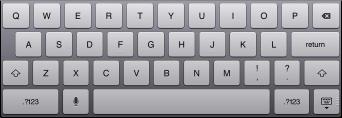
Switch the language when using a hardware keyboard: Press Command–Space bar to display a list of available languages. Press the Space bar again to choose a language.
Turn offa wireless keyboard: Hold down the On/off switch on the keyboard until the green light goes off.
iPad disconnects the keyboard when the keyboard is turned off or out of range.
Unpair a wireless keyboard: Go to Settings > Bluetooth, tap  next to the keyboard name, then tap “Forget this Device.”
next to the keyboard name, then tap “Forget this Device.”
Dictation
On an iPad that supports it, you can dictate text instead of typing. To use dictation, Siri must be turned on and iPad must be connected to the Internet. You can include punctuation and give commands to format your text.
Note: Dictation may not be available in all languages or in all areas, and features may vary. Cellular data charges may apply.
Turn on dictation: Go to Settings > General > Siri, then turn on Siri.
Dictate text: From the onscreen keyboard, tap  , then speak.When you finish, tap
, then speak.When you finish, tap  .
.
 Tap to begin dictation.
Tap to begin dictation.
To add text, tap  again and continuing dictating. To insert text, tap to place the insertion point first.You can also replace selected text by dictating.
again and continuing dictating. To insert text, tap to place the insertion point first.You can also replace selected text by dictating.
Add punctuation or format text: Say the punctuation or formatting command.
For example,“Dear Mary comma the check is in the mail exclamation mark” results in “Dear Mary, the check is in the mail!”
Punctuation and formatting commands include:
••
••
••
••
••
••
••
••
••
••
••
quote … end quote new paragraph
cap—to capitalize the next word
caps on … caps off—to capitalize the first character of each word all caps—to make the next word all uppercase
all caps on … all caps off—to make the enclosed words all uppercase no caps on … no caps off—to make the enclosed words all lowercase no space on … no space off—to run a series of words together smiley—to insert :-)
frowny—to insert :-( winky—to insert ;-)
Chapter 3 Basics |
26 |
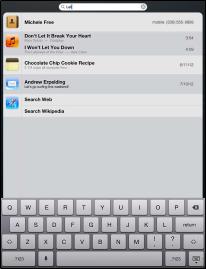
Searching
You can search many of the apps on iPad, as well as Wikipedia and the web. Search an individual app, or search all the apps at once using Spotlight. Spotlight also searches the names of apps on iPad—if you have a lot of apps, you might want to use Spotlight to locate and open them.
Search an individual app: Enter text in the search field.
Search iPad using Spotlight: Swipe right from the first Home screen, or press the Home button from any Home screen. Enter text in the search field.
from any Home screen. Enter text in the search field.
Search results appear as you type. To dismiss the keyboard and see more results, tap Search. Tap an item in the list to open it. The icons let you know which apps the results are from.
iPad may display a top hit for you, based on previous searches.
Spotlight searches the following:
•• Contacts—All content
•• Apps—Titles
•• Music—Names of songs, artists, and albums, and the titles of podcasts and videos
•• Podcasts—Titles
•• Videos—Titles
•• Audiobooks—Titles
•• Notes—Text of notes
•• Calendar (Events)—Event titles, invitees, locations, and notes
•• Mail—To, From, and Subject fields of all accounts (the text of messages isn’t searched)
•• Reminders—Titles
•• Messages—Names and text of messages
Search the web or Wikipedia from Spotlight: Scroll to the bottom of the search results, then tap Search Web or Search Wikipedia.
Open an app from Search: Enter all or part of the app name, then tap the app.
Choose which items are searched, and the order they’re searched: Go to Settings > General > Spotlight Search.
Chapter 3 Basics |
27 |

Notifications
To help make sure you don’t miss important events, many iPad apps can provide alerts. An alert can appear briefly as a banner at the top of the screen, which goes away if you don’t respond to it, or as a notice in the center of the screen that remains until you acknowledge it. Some apps can also display badges on their icons on the Home screen, to let you know how many new items await—for example, how many new email messages you have. If there’s a problem—such as a message that couldn’t be sent—an exclamation mark  appears on the badge. A numbered badge on a folder shows the total number of alerts for all the apps in the folder.
appears on the badge. A numbered badge on a folder shows the total number of alerts for all the apps in the folder.
Alerts can also appear on the Lock screen.
Respond to an alert when iPad is locked: Swipe it from left to right.
Notification Center displays all your alerts in one place. So if you weren’t able to respond when you first received an alert, you can use Notification Center to respond when you’re ready. Alerts can include:
••
••
••
••
••
••
Missed FaceTime calls New email
New text messages Reminders Calendar events
Friend requests (Game Center)
If you’re signed in to your Twitter or Facebook account, you can post or tweet to your account from Notification Center.
View Notification Center: Swipe down from the top of the screen.
•• Respond to an alert: Tap it.
•• Remove an alert: Tap  , then tap Clear.
, then tap Clear.
Chapter 3 Basics |
28 |
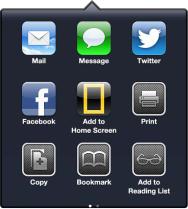
Manage alerts for your apps: Go to Settings > Notifications.See Do Not Disturb & Notifications on page 113.
Choose alert sounds,adjust the alert volume,or turn vibrate on or off: Go to Settings > Sounds.
Sharing
iPad gives you lots of ways to share with other people.
Sharing within apps
In many apps, tapping  displays options for sharing, as well as other actions such as printing or copying. The options vary depending on the app you’re using.
displays options for sharing, as well as other actions such as printing or copying. The options vary depending on the app you’re using.
Sign in to your Facebook account (or create a new account) in Settings to enable posting directly from many of the apps on iPad.
Sign in to or create a Facebook account: Go to Settings > Facebook.
Post from Notification Center: Tap “Tap to Post.”To turn this feature on, go to Settings >
Notifications > Share Widget.
Post using Siri: Say “Post to Facebook ….”
Post an item from an app: In most apps, tap  . In Maps, tap
. In Maps, tap  , tap Share Location, then tap Facebook.
, tap Share Location, then tap Facebook.
Set options for Facebook: Go to Settings > Facebook to:
•• Update Contacts on iPad with Facebook names and photos
•• Allow apps (such as Calendar and Contacts) to use your account Install the Facebook app: Go to Settings > Facebook, then tap Install.
Sign in to your Twitter account (or create a new account) in Settings to enable Tweets with attachments from many of the apps on iPad.
Sign in to or create a Twitter account: Go to Settings > Twitter.
Tweet from Notification Center: Tap “Tap to Tweet.”To turn this feature on, go to Settings >
Notifications > Share Widget.
Tweet using Siri: Say “Tweet ….”
Chapter 3 Basics |
29 |

Tweet an item from an app: View the item, tap  , then tap Twitter. If
, then tap Twitter. If  isn’t showing, tap the screen. To include your location, tap Add Location.
isn’t showing, tap the screen. To include your location, tap Add Location.
Tweet a location in Maps: Tap the location pin, tap  , tap Share Location, then tap Twitter.
, tap Share Location, then tap Twitter.
When you’re composing a Tweet, the number in the lower-right corner of the Tweet screen shows the number of characters remaining that you can enter. Attachments use some of a Tweet’s 140 characters.
Add Twitter user names and photos to your contacts: Go to Settings > Twitter, then tap Update Contacts.
Set options for Twitter: Go to Settings > Twitter.
Install the Twitter app: Go to Settings > Twitter, then tap Install.
Connecting iPad to a TV or other device
You can use AirPlay with Apple TV to stream content to an HDTV, or connect iPad to your TV using cables.
AirPlay
With AirPlay, you can stream music, photos, and video wirelessly to Apple TV and other AirPlay-enabled devices. The AirPlay controls appear when an AirPlay-enabled device is available on the same Wi-Fi network that iPad is connected to. You can also mirror the contents of your iPad screen on a TV.
Stream content to an AirPlay-enabled device: Tap  and choose the device.
and choose the device.
Access the AirPlay and volume controls while using any app: When the screen is on, double-click the Home button  and scroll to the left end of the multitasking bar.
and scroll to the left end of the multitasking bar.
AirPlay Volume
Switch playback back to iPad: Tap  and choose iPad.
and choose iPad.
Mirror the iPad screen on a TV: Tap  at the left end of the multitasking bar, choose an Apple TV, and tap Mirroring. A blue bar appears at the top of the iPad screen when AirPlay mirroring is turned on. Everything on the iPad screen appears on the TV.
at the left end of the multitasking bar, choose an Apple TV, and tap Mirroring. A blue bar appears at the top of the iPad screen when AirPlay mirroring is turned on. Everything on the iPad screen appears on the TV.
Connecting iPad to a TV using a cable
Apple cables and adapters (available separately) may be used to connect iPad to a TV, projector, or other external display. For more information, go to support.apple.com/kb/HT4108.
Printing with AirPrint
AirPrint lets you print wirelessly to AirPrint-enabled printers from the following iOS apps:
••
••
••
••
Mail—email messages and attachments that can be viewed in Quick Look Photos and Camera—photos
Safari—webpages, PDFs, and other attachments that can be viewed in Quick Look iBooks—PDFs
Chapter 3 Basics |
30 |
